Dee Estuary Birding
Monthly Newsletter...
June 2021 Newsletter

Wetland Bird Survey 2019/20
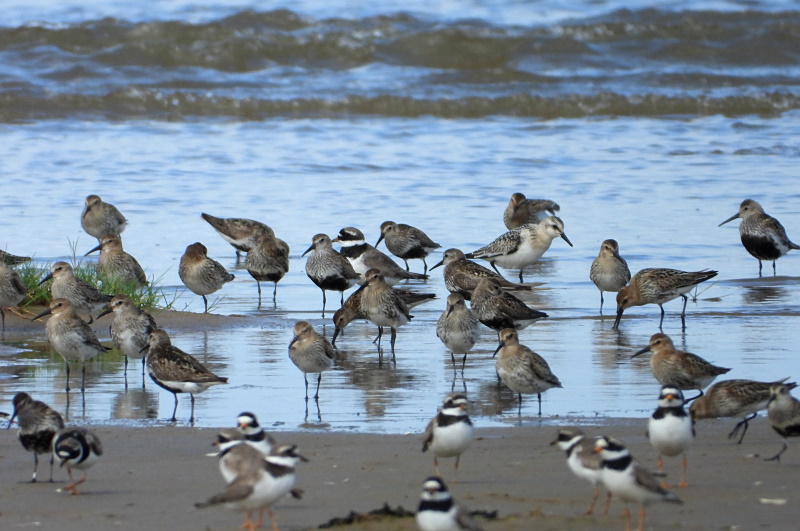
Both the local, Dee Estuary, and National Wetland Bird Survey Reports
for 2019/20 have just been published and, as always, gives us the
opportunity to see how our wetland birds are doing.
The WeBS pages on the BTO website are a tremendous
resource. The latest report can be downloaded for free and you can look
at all the updated data, including that for the Dee Estuary. But not
only that, data goes all the way back to 1965/66 when the then Birds of
Estuary Enquiry started. It might amuse you to look at that year for
the Dee Estuary when the total count for all species, according to the
table, was just
two Pink-footed Geese! But that was the only species they counted that
year (we get quite a few more these days - see below) and it wasn't
until 1970/71 that a full survey was undertaken. All the annual reports
going back to 1999/20 are also available. See Ref 3 for the link.
The index for the latest report, 2019/20, is shown below to give you an idea of the contents. Full of interesting articles, I found the four Species Focus articles of particular interest.

I will now just briefly summarise some of the highlights from the Dee
Estuary:
Pink-footed Geese
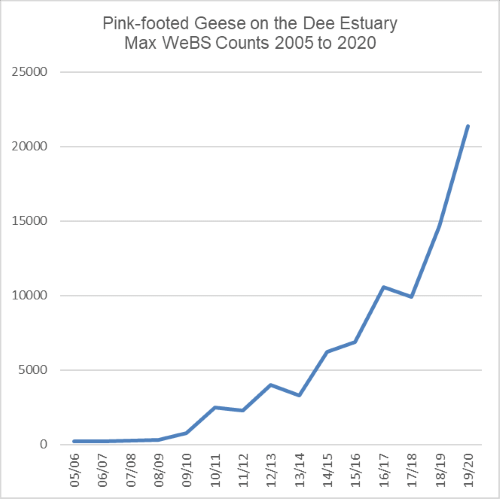
The increase in Pink-footed Geese numbers on the Dee
Estuary over the past 10 years has been phenomenal, and shows no sign
of slowing down any time soon. In 2019/20 the Dee Estuary was the
seventh most important site in the country. An amazing achievement when
you consider the six sites with more birds includes major sites in
Scotland, such as Montrose Basin and Moray Firth as well as major
English sites such as North Norfolk and Martin Mere. I quote from the
Dee Estuary WeBS Report 2019/20 which summarises their movements: "During
the autumn and early winter many birds spend most of their time feeding
on fields along the Wirral side of the estuary and further inland along
the Dee valley (at least as far as Aldford) but usually returning to
roost on the estuary (so not recorded in Dee Estuary WeBS counts). This
winter birds were recorded even more widely eg 500 present at Bar Mere
with birds often seen arriving from the north west during the morning.
As winter progresses, they spend more time grazing the saltmarsh off
Parkgate and in late winter, with the cessation in shooting, they move
onto Burton Marsh."
Egrets

There is certainly something about the Dee Estuary
which the Egrets love. Last year I was reporting that in 2018/19 the
Dee Estuary had the highest count in the country for Little Egrets
with a roost count of 425 in August 2018. Only 260 were counted in
2019/20 but that will be a big underestimate as a full roost count was
not undertaken. However, there were a record number of pairs breeding
in the estuary with a total at two sites of at least 110.
Great Egret numbers on the Dee Estuary were the second highest in the country in 2019/20 with 29, second only to the Somerset Levels with 62. Three pairs bred successfully fledging 11 young. Note the max number counted in 2019/20, on a non-WeBS day, was 35 on August 2019.
Ducks
Last year I was reporting really good numbers of ducks for the winter of 2018/19, unfortunately the reverse happened in 2019/20 with all our commoner ducks showing a fall in numbers. This was thought to be due them staying further east and north due to a very mild winter on the continent. Typically Teal have shown the wildest fluctuations in numbers with a max of 3,084 in 2017/18, 9,892 in 2018/19 and 4,152 in 2019/20 ( see Species Spotlight - Teal).
Waders
Wader counts were also generally on the low side in 2019/20. But it is good to see numbers of Curlew increasing on the Dee Estuary for three years running. The Dee Estuary was the third most important site for this species in 2019/20 and the five year average is 3,553.
Knot numbers in the country increased significantly
and the index was the third highest since WeBS began in the late 1960s,
this was due to an exceptionally good breeding season in 2019. The Wash
is by far the most important site in the country for them and they
always peak there in the autumn when birds which have moulted on the
Waddensea start moving west. In 2019 numbers peaked in September on the
Wash with a remarkable 199,625.
Knot is a difficult species to count on the Dee
Estuary, at low tide they are scattered over miles of mud banks whereas
at high tide many leave the estuary altogether to roost anywhere
between Southport and Seaforth (the latter undisturbed site has become
increasingly important in recent years). What the data shows in the
2019/20 season illustrates the point. The January 12th high tide count
for WeBS was only 5,185, but a few days earlier, on January 4th, Steve
Hinde had 22,000 off Thurstaston at low tide and this was submitted as
a WeBS supplementary count and it is this larger count shown in the BTO
WeBS data. Incidentally a Low Tide WeBS count in November 2020 gave a
nice high count with large numbers of birds on Dawpool Bank off
Thurstaston, I'm not sure what the total figure was but it will be well
over 30,000.
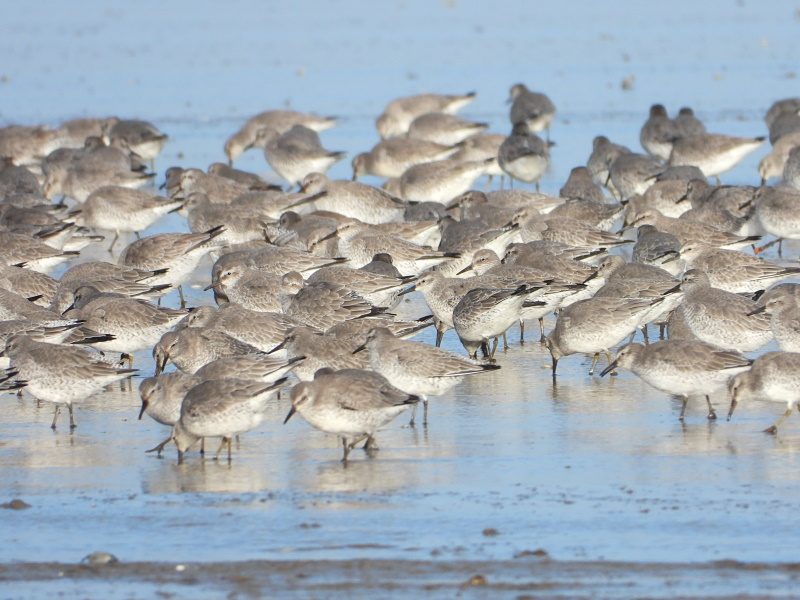
References
1. Neil Friswell (Approved by Colin Wells), Dee Estuary and North Wirral Foreshore WeBS Annual Report 2019/20.
2. Frost T.M. et al., Waterbirds in the UK - Summary
report 2019/20:
https://www.bto.org/our-science/projects/wetland-bird-survey/publications/webs-annual-report/waterbirds-in-the-uk
https://app.bto.org/webs-reporting/numbers.jsp
Richard Smith
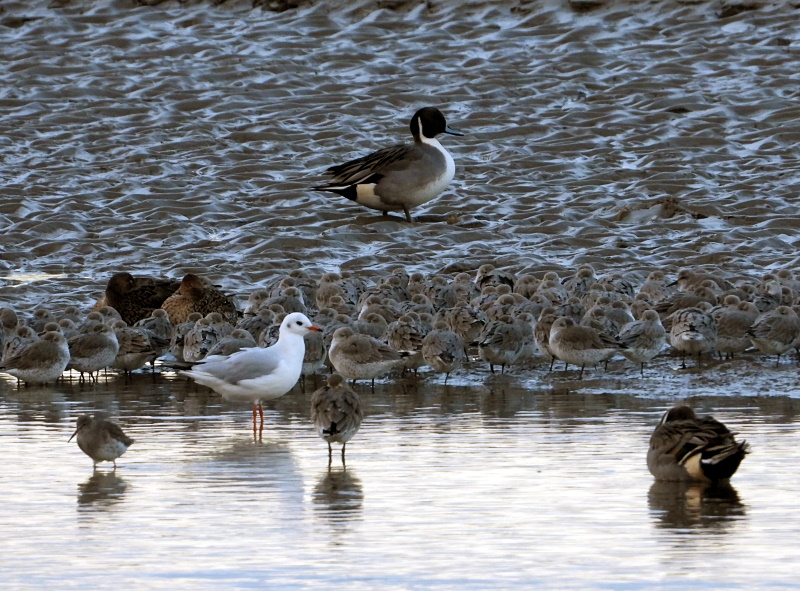
Redpolls
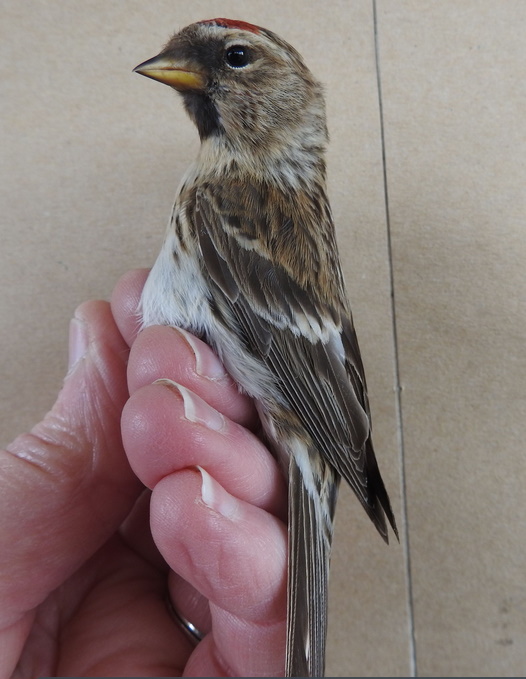
"Redpolls continue
to fascinate and baffle in equal measure. This was the 80th this week -
undertail that an expiles
would be proud of, head that appears to have come from a rostrata and biometrics that rule nothing in or
out". Twitter:
@Turnershbo Apr 22, 2021.
There is a substantial spring passage of Redpolls
through the Dee Estuary and north Wirral in most years. The peak
of the passage occurs at a time when any local birds should be nesting
and the similarity of the passage to movements of Iceland/Greenland
bound Wheatears and White Wagtails makes it tempting to suggest that
the Redpolls too are heading that way.
Redpoll taxonomy is on one hand complicated and on the other hand
incredibly simple. Knox 1988 [Ref 1.], is still regarded as the "bible"
for Redpoll taxonomy, names 6 forms,
[1] cabaret [Lesser Redpoll -
small buffy brown]
[2] flammea [Mealy Redpoll,
larger, paler]
[3] rostrata [Greater or
Greenland Redpoll huge and brown]
[4] hornemanni [Hornemann's
Arctic Repoll - huge and pale]
[5] exilipes [Coue's Arctic
Redpoll - long-tailed small-billed and very pale]
[6] islandica [Icelandic
Redpoll - often regarded as a hybrid swarm between rostrata and
hornemanni that as a rule are large, with dark birds outnumbering pale
birds by about 10:1]
On the other hand, more recent DNA studies [ Ref 2, Mason & Taylor
2015 ] suggest that there is only one species of Redpoll and the huge
variation that is seen in them comes from gene expression. They
suggest the size, shape and plumage of Redpolls develop with time as a
response to their environment eg. Shorter, thicker bills, and longer
tails for birds that predominately feed on the ground.
A quick internet image search of Icelandic Redpolls - [use
"Aušnutittlingur" as a search term], shows that the situation there is
even more complex than the literature suggests. With birds of every
appearance imaginable, including ones that look just like Lesser
Redpoll. Around half the Icelandic population is migratory, and it
seems likely that they winter in Western Europe, though there are no
ringing recoveries to support this. The dark birds would be hard to
differentiate from Lesser Redpoll unless they were really big ones,
whilst the pale birds might easily be mistaken for exilipes,
only their more robust bills giving them away. The birds which
pass Wirral in late spring, and are also recorded in North Wales,
Northern Ireland and NW Scotland, include birds which appear to be
"North Western" , i.e. rostrata/dark
islandica and a few pale islandica, mainly from Greenland
and Iceland.
In 2021 I've caught 130 Redpolls. None of them have been big
enough to be certain North-Western (NW) birds which should be from 73
to 85mm in wing length, though some could be at the very bottom end of
the population and some really have the long winged, long tailed
large-billed swarthy look of dark NW birds. What is clear is that
as a cohort they are bigger than standard British birds, which average
69mm wing length (cabaret).

I've been sound recording the birds as I release them, and it would
appear that many would not sound out of place in Iceland:
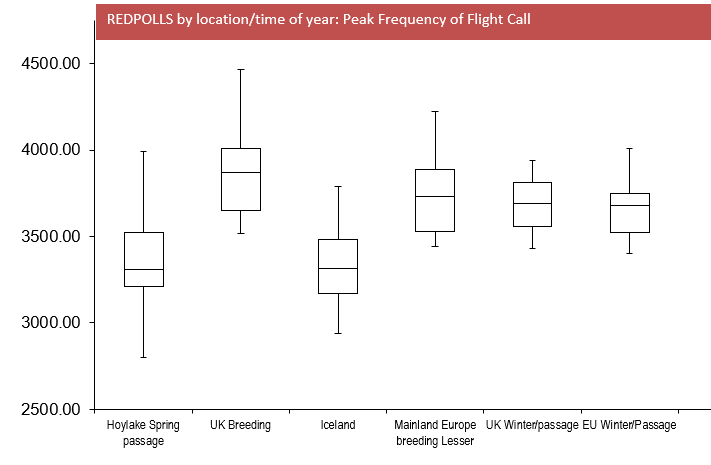
Plumage and structure-wise they are amazingly varied.
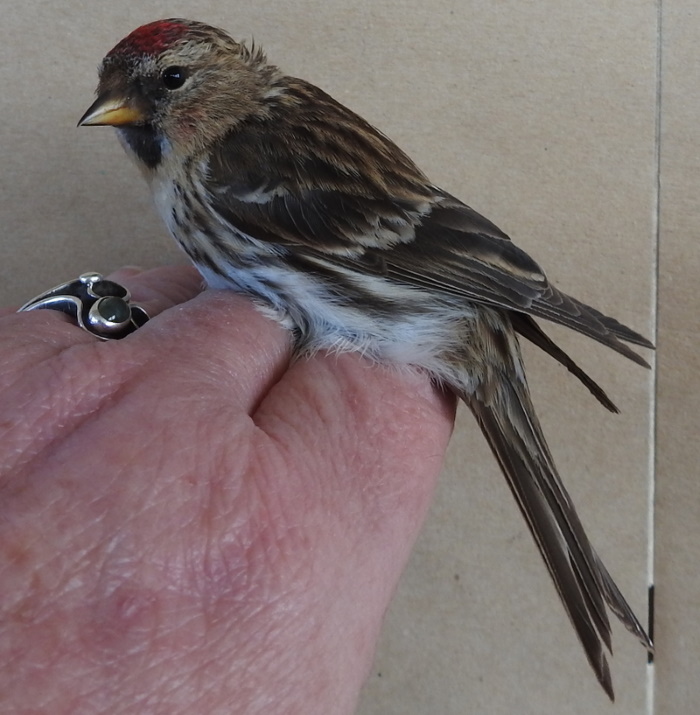
This, above, has the structure and plumage of NW Redpoll, long-winged,
long-billed and exceptionally long-tailed, though it's not big enough.
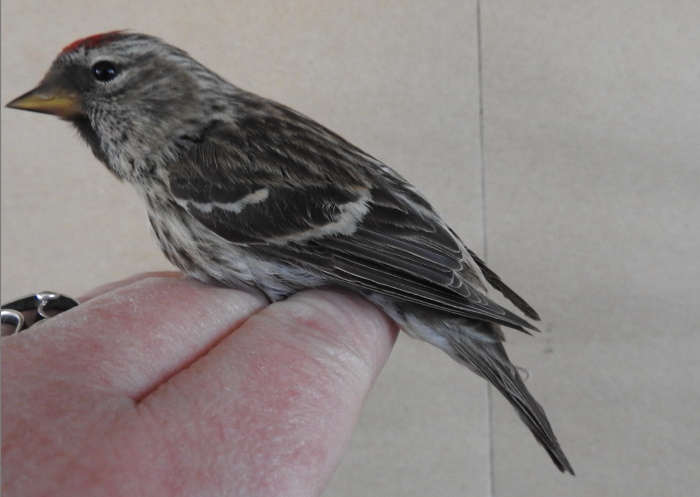
This one is cold/grey, also large-billed, but very short-tailed.

These two were caught on the same day - the long-billed bird above was
nearly 2cm shorter in body length than its companion.
What is I think most telling is the number of birds that have mixed
characteristics - i.e a rump from one form and undertail from another.
for example:

This bird has heavily streaked rump, but a completely unmarked
undertail - like exilipes.

Whilst this one has a rump that could pass as exilipes, but quite a streaky
undertail.
I think that the most plausible explanation for these birds is that
there is a mixed population of Icelandic and Lesser Redpolls
somewhere. Whether this is in Iceland, as suggested by the
passage dates, or perhaps in NW Scotland, remains to be
determined. Certainly, Icelandic Redpolls have been suspected of
breeding in the Outer Hebrides [Andrew Stevenson pers.comm] though the
numbers passing through NW UK in May do suggest a much very larger
population than is known to breed in the Uists. It's also
possible that the studies in Iceland, which have relatively small
sample sizes for the migrant population, have missed these birds.
Hopefully there will be some recoveries that shed light on this.
References:
1. Knox, A, The Taxonomy of Redpolls, Ardea 76,
p1-26 1988
2. Mason, N.A & Taylor S.A, Differentially expressed genes match
bill morphology and plumage despite largely undifferentiated genomes in
a Holarctic songbird, Molecular Ecology, 24:12 3009-3025 2015
Jane Turner
(all photos and graphs in this Redpoll article © Jane Turner).
May Bird News

they usually leave here well before early May and when they return in July are already moulting © Richard Smith
Lots of waders were coming through early in the month including a
record high Dee Estuary count of 173 Whimbrel at Heswall on the 1st,
smashing last year's record of 142 at the same location. At least two
were still at Heswall by the month-end. A great sight
was a mixed flock of over 2,000 Dunlin, Knots and Grey Plovers more or
less in full summer plumage on the 4th. This is a late date for s/pl
Knot which would normally have been expected to be already in Iceland
(where they stage before moving on to Canada), no doubt they were held
up by a strong northerly. On the same date there were 3,500 Dunlin and
1,000 Knot off Heswall, but distant. At least 12 Spotted Redshank
was an excellent count at Burton Mere Wetlands on the 2nd and a Wood
Sandpiper was a good find at 'Pasture Flash' in Moreton on the 24th.

The first Spotted Flycatcher of the spring was recorded at Leasowe
Lighthouse on the 9th, the same day there was at least 20 Whinchats
there. Four Wood Warblers through the month was a good number for what
has now become a scarce bird.
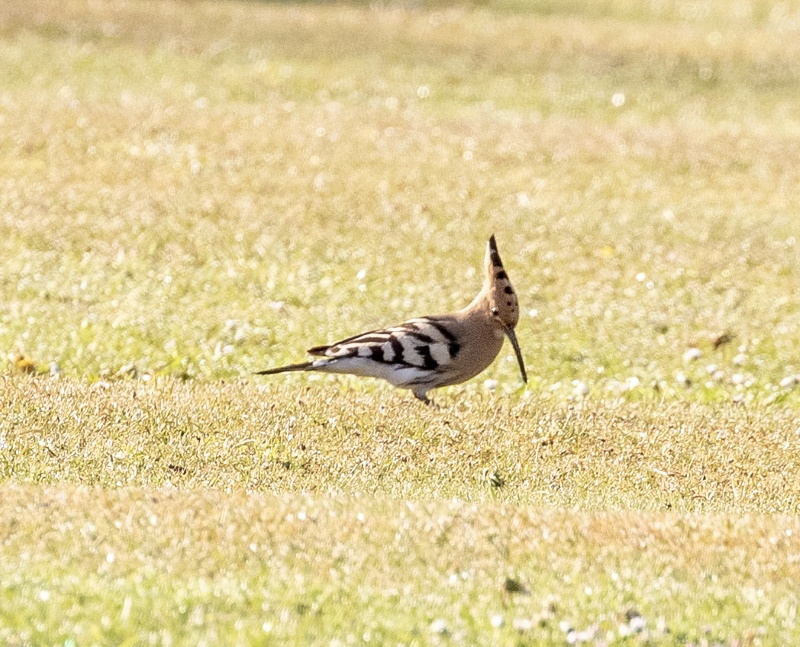
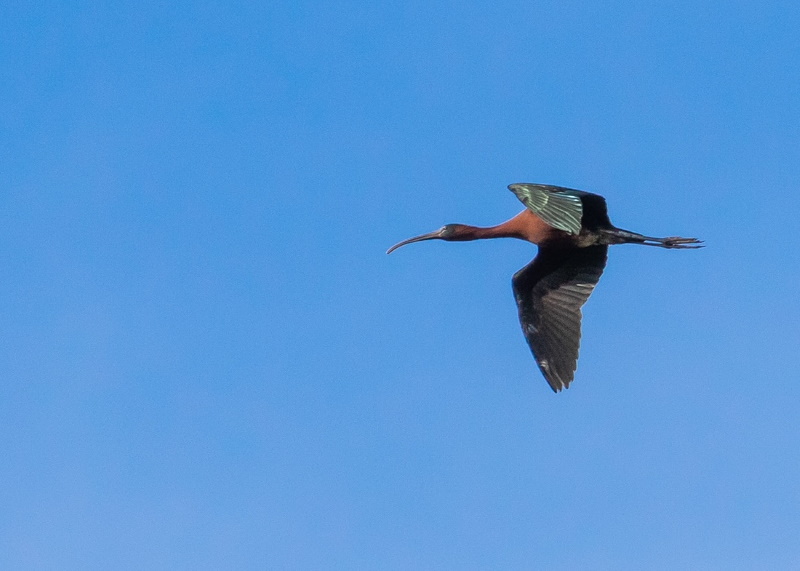
But the big story of the month was some great
rarities. It started with a Hoopoe on the 8th and 9th at Hoylake then,
remarkably, last month's Collared Pratincole was spotted at Leasowe on
the 14th but only a flyover. A Common Crane landed on Burton Marsh in
some appalling weather on the 16th. Burton Mere Wetlands then had both
a Bonaparte's Gull and Glossy Ibis on the 23rd. Also at Burton Mere
Wetlands the Bittern continued to show well and at least two pairs of
Bearded Tits are nesting. Three Spoonbills were seen both at BMW and on
the marshes from Burton to Parkgate.
Short-eared Owls is not a species usually associated with May but there were five records ranging from Gronant, to Burton and Leasowe. Out to sea up to four Eiders were off Hilbre through the month but otherwise it was quiet until a westerly gale on the 25th which blew in a good number of sea birds including 75 Manx Shearwaters.
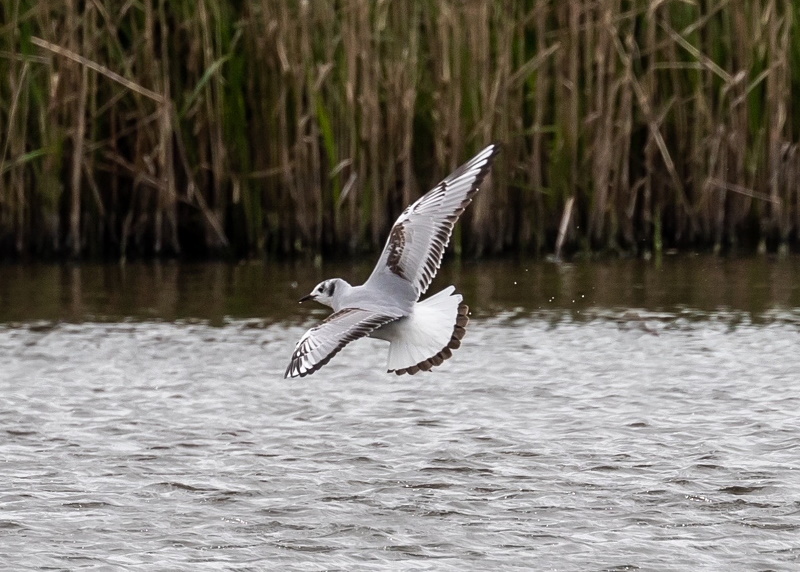
What to expect in June
June is the quietest month of the year but I find it fascinating being a month of transition between spring and autumn. In the first few days of June Grey Plovers, Ringed Plover and Sanderling will still be on their way north. Look at these birds with awe as some will have come all the way up from South Africa and will end up nesting within the Arctic Circle. By the end of the month early breeding birds will have returned including spotted Redshanks, Common, Green and Wood Sandpipers as well as Black-tailed Godwits, Curlew and Redshank. Many non-breeding birds, of course, don't actually leave us and these always include Oystercatchers and, perhaps more unexpectedly, a few Whimbrel. After an exceptionally good breeding season in 2019 we had thousands of immature knot visiting us in June 2020, and I would be surprised if we don't get some of these again this year.
But perhaps the most obvious build-up is of gulls.
These will be mainly Black-headed Gulls but will include a few
Mediterranean Gulls which will still be in full summer plumage. Lesser
Black-backed Gulls are always surprisingly numerous and we always get a
few hundred roosting off Heswall shore. Then we will get the welcome
return of Sandwich Terns, just a few by the end of June but many more
to come in July.
For many birds the breeding season is still very
much underway and a visit to Gronant to see the Little Terns will be a
wonderful spectacle. Although a strong westerly would be unwelcome at
Gronant it would at least result in plenty of seabirds passing through
Liverpool Bay including Gannets and Manx Shearwaters, and the
occasional Storm Petrel.
Forthcoming Events
June Highest Spring Tides (Liverpool)
Also see Tides page.
24th June, 11.21hrs (BST), 9.3m.
25th June, 12.12hrs (BST), 9.4m.
26th June, 13.03hrs (BST), 9.3m.